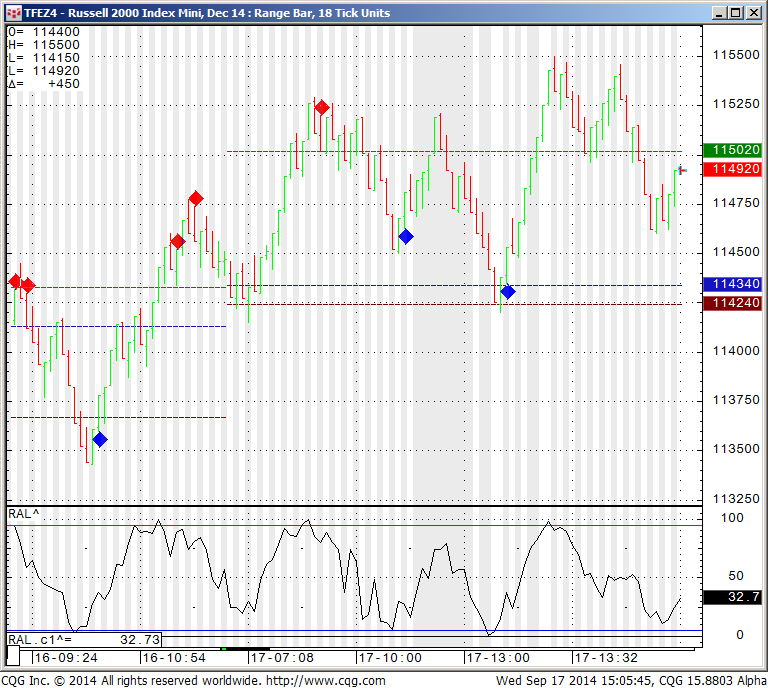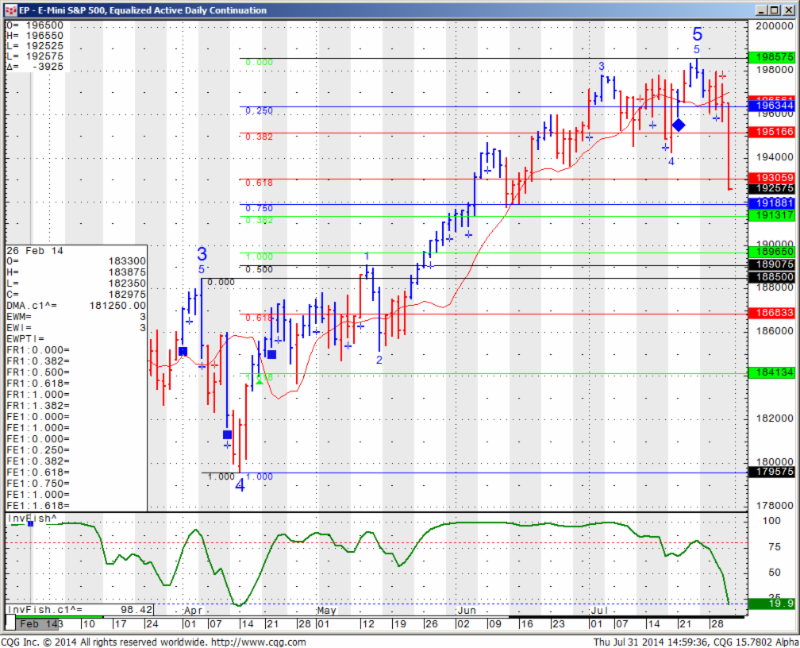As I usually try to do on Mondays, a little on the fundamental side that affected trading in the past few days and should have an effect on trading this week. From our friends at www.TradeTheNews.com
– It may be August but markets refuse to settle into a sleepy late summer trading pattern as even more geopolitical shocks and economic slowdown in Europe and Asia keep things very interesting. US stock averages were on track for their best gains in several weeks until heightened tensions in eastern Ukraine knocked them over on Friday and sent the 10-year UST yield to one-year lows around 2.322% and the German 10-year Bund below the 1% mark for the first time ever. In Brazil, the death of an opposition presidential candidate threw the campaign into turmoil, while there was finally some good news out of Iraq. Terrible European GDP data and worrying numbers in Asia left serious questions about the sustainability of the global economic recovery. Stocks continued to climb the wall of worry, and for the week the DJIA rose 0.7%, the S&P500 gained 1.2%, and the Nasdaq added 2.2%.- The situation in Ukraine kept markets off balance this week, as stories of escalation and de-escalation alternated in quick succession. Kiev was tightening the noose around separatist strongholds Donetsk and Lugansk as the Russian authorities dispatched a humanitarian aid convoy of 280 trucks to help civilians in eastern Ukraine, although Kiev and the Western powers reacted to the move as a thinly-veiled provocation. In a speech on Thursday, Russian President Putin said his government would do “all it can” to stop the conflict in Ukraine and asserted that Russia should not isolate itself from the outside world, inspiring a sense that finally de-escalation was at hand. But within 24-hours of Putin’s dovish speech, an incursion into Ukrainian territory by a column of purported Russian armored vehicles and a Ukraine army attack on the column briefly prompted fears that the crisis was headed for a more serious confrontation.
– Data out this week stoked fears of economic slowdown in Asia and Europe. In China, the July new yuan loans measure plunged by two-thirds m/m to the lowest level since January 2010, reviving talk about a Chinese economic hard landing. German GDP shrank 0.2% sequentially, putting the annualized figure at +0.8%, while French and Eurozone q/q GDP was flat. Japan initial second quarter GDP saw the economy contract by the biggest margin since the massive earthquake three years ago, although the drop was not as bad as expected. The numbers were widely expected, given the increase in sales tax, however the 5% contraction in private consumption was much bigger than the -3.7% expected. The one bright spot was the UK, where a modest expansion continued, with preliminary GDP +0.8% q/q and +3.2% y/y.
– The JOLTS report out this week showed that job openings surged to their highest level in over a decade in June. The data suggests there are about two unemployed job seekers for each available job in the economy. Fed Chair Yellen has referred to the JOLTS report as one of her key metrics for gauging labor demand in the US economy, and investors will be closely watching her remarks for any hawkish tones at her Jackson Hole speech next Friday which will focus on the labor market.
– The outbreak of the Ebola virus in West Africa continues to escalate, with about 2,000 confirmed cases reported from Guinea, Liberia, Nigeria, and Sierra Leone, and the mortality rate running over 50%. The WHO has warned that there is evidence that the number of reported cases and deaths vastly underestimate the magnitude of the outbreak.
– After massive pressure from a wide spectrum of domestic political players plus the US and Iran, Iraq PM Maliki stepped down this week after Iraqi President Masoum designated a new candidate to form a government. There had been fears Maliki would try to foment a coup and hold on to power, however the armed forces gave him no support, undercutting his position. Late in the week, leaders of the Sunni and Kurdish factions threw tentative support behind the new PM, Al-Abadi, raising hopes for a more inclusive and cohesive government. In the north, US airstrikes seemed to lift the siege of the Yazidi minority trapped on Mount Sinjar, but ISIS remains as strong as ever.
– Kinder Morgan announced plans this week to eliminate its master limited partnership structure and consolidate the four Kinder firms – Kinder Morgan Energy Partners, El Paso Pipeline Partners and Kinder Morgan Management – into one company. All four names rocketed higher after Kinder Morgan announced the $70 billion megadeal, which caught observers by surprise considering that Kinder was the first major energy firm to pioneer the MLP approach. The new Kinder Morgan entity will pay out a very generous dividend of $2/share in 2015, up 16% from this year.
– The July US advance retail sales numbers were flat, for the worst reading in the series in six months. The ex-autos figure was little better, at +0.1%. Analysts suggested that the weak July data is merely making up for unexpectedly strong numbers in May and June. Retail majors Macy’s and Walmart released very soft second-quarter results and trimmed forward guidance. JCPenny, Nordstrom, and Kohl’s reported decent quarterly numbers, with JCP and JWN both disclosing positive comps and higher guidance.
– Retail analyst firm ChannelAdvisor released estimated July SSS figures for Amazon and eBay. It said that Amazon July SSS were +40.4% versus June SSS of +34.4%, and estimated eBay July SSS +9.7% versus June SSS +12.3%. Shares of Amazon gained after the report while shares of eBay lost ground this week.
– In other earning news, Cisco reported flattish fourth-quarter performance and first-quarter guidance, which was received by markets without much enthusiasm. The company also launched another round of sizable job cuts, reducing the workforce to refocus on its strongest business segments. Deere mowed down its FY14 forecasts, and saw both earnings and revenue decline on a y/y basis. SeaWorld shares sank after a terrible quarter as gate receipts plummets, and the company responded to recent bad press by announcing it would improve the habitat areas for its signature orcas.
– The weak European GDP numbers and the continuing geopolitical tensions aided dollar strength. EUR/USD retested the nine-month lows seen last week, briefly dropping below 1.3340. Euro sell stops are said to be clustered below 1.3330. The BoE Quarterly Inflation Report was nowhere near as hawkish as expected, as it merely amended its spare capacity view to 1.00-1.25% from 1.00-1.50% prior and trimmed the wage growth forecast for 2014 and 2015. The BoE said there were no numerical thresholds for wage growth to trigger a rate hike. This contrasts sharply with Governor Carney’s earlier more hawkish tone. GBP/USD tested four-month lows in the aftermath of the report, around 1.660, and racked up its sixth straight week of losses.


